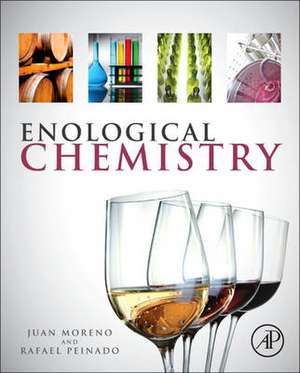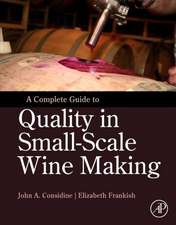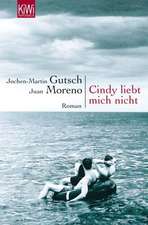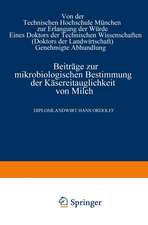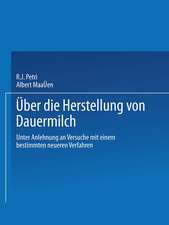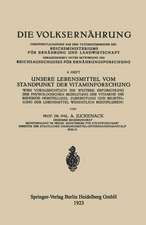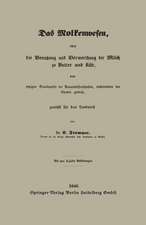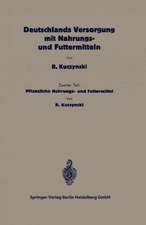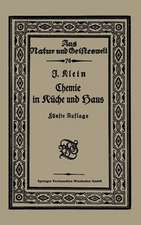Enological Chemistry
Autor Juan Moreno, Rafael Peinadoen Limba Engleză Hardback – 29 mai 2012
The topics in the book have been sequenced identically with the steps of the winemaking process. Thus, the book describes the most salient compounds involved in each vinification process, their properties and their balance; also, theoretical knowledge is matched with its practical application. The primary aim is to enable the reader to identify the specific compounds behind enological properties and processes, their chemical balance and their influence on the analytical and sensory quality of wine, as well as the physical, chemical and microbiological factors that affect their evolution during the winemaking process.
- Organized according to the winemaking process, guiding reader clearly to application of knowledge
- Describes the most salient compounds involved in each step enabling readers to identify the specific compounds behind properties and processes and effectively work with them
- Provides both theoretical knowledge and practical application providing a strong starting point for further research and development
Preț: 526.59 lei
Preț vechi: 643.06 lei
-18% Nou
Puncte Express: 790
Preț estimativ în valută:
100.76€ • 105.42$ • 83.70£
100.76€ • 105.42$ • 83.70£
Carte tipărită la comandă
Livrare economică 26 martie-09 aprilie
Preluare comenzi: 021 569.72.76
Specificații
ISBN-13: 9780123884381
ISBN-10: 0123884381
Pagini: 442
Dimensiuni: 191 x 235 x 28 mm
Greutate: 1.02 kg
Editura: ELSEVIER SCIENCE
ISBN-10: 0123884381
Pagini: 442
Dimensiuni: 191 x 235 x 28 mm
Greutate: 1.02 kg
Editura: ELSEVIER SCIENCE
Public țintă
Researchers and enologists developing new wine products, some limited potential for advanced students in courses on Enology and Wine Chemistry.Cuprins
Chapter 1. The Vine
Chapter 2. Composition of Grape Must
Chapter 3. Must Aromas
Chapter 4. Composition of Wine
Chapter 5. Polyphenols
Chapter 6. Sugars: Structure and Classification
Chapter 7. Sugars in Must
Chapter 8. Carboxylic Acids: Structure and Properties
Chapter 9. Grape Acids
Chapter 10. The Relationship between Must Composition and Quality
Chapter 11. The Transformation of Must Into Wine
Chapter 12. Nitrogen Compounds
Chapter 13. Acid–Base Equilibria in Wine
Chapter 14. Buffering Capacity of Wines
Chapter 15. Precipitation Equilibria in Wine
Chapter 16. Changes in Acidity After Fermentation
Chapter 17. Redox phenomena in Must and Wine
Chapter 18. The Colloidal State
Chapter 19. Wine Colloids
Chapter 20. Inorganic Material and Metal Casse
Chapter 21. Chemical Aging
Chapter 22. Aging
Chapter 23. Biological Aging
Chapter 2. Composition of Grape Must
Chapter 3. Must Aromas
Chapter 4. Composition of Wine
Chapter 5. Polyphenols
Chapter 6. Sugars: Structure and Classification
Chapter 7. Sugars in Must
Chapter 8. Carboxylic Acids: Structure and Properties
Chapter 9. Grape Acids
Chapter 10. The Relationship between Must Composition and Quality
Chapter 11. The Transformation of Must Into Wine
Chapter 12. Nitrogen Compounds
Chapter 13. Acid–Base Equilibria in Wine
Chapter 14. Buffering Capacity of Wines
Chapter 15. Precipitation Equilibria in Wine
Chapter 16. Changes in Acidity After Fermentation
Chapter 17. Redox phenomena in Must and Wine
Chapter 18. The Colloidal State
Chapter 19. Wine Colloids
Chapter 20. Inorganic Material and Metal Casse
Chapter 21. Chemical Aging
Chapter 22. Aging
Chapter 23. Biological Aging
Recenzii
"Moreno and Peinado draw material from lectures and laboratory sessions in a course on wine chemistry they have taught to enology students for over 10 years. The textbook synthesizes the considerable scientific knowledge that has been acquired about making wine, much of which has not been widely disseminated." --Reference and Research Book News, December 2012
